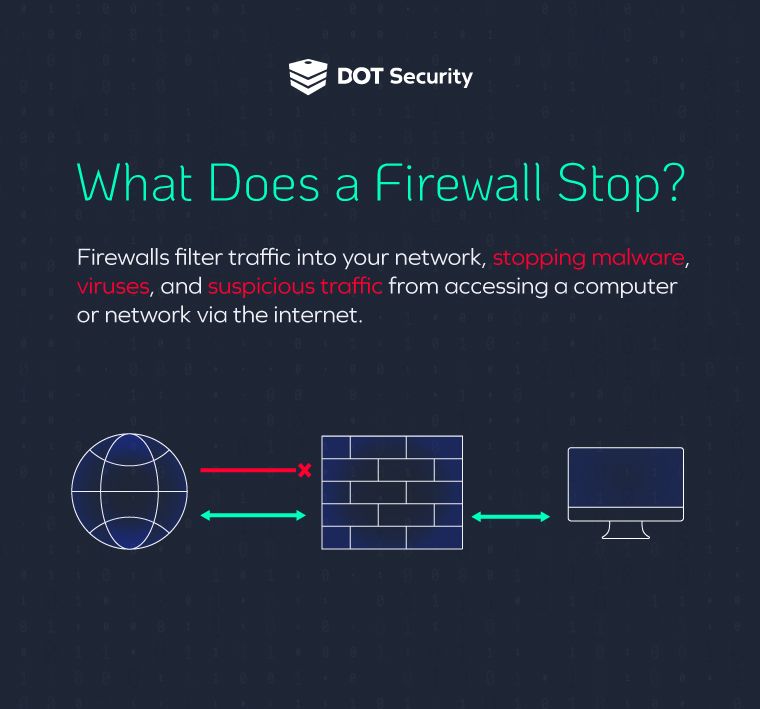Network Security Monitoring
What is a Firewall and How Does it Help Network Security?
May 19, 2022
6 minutes

Most people are aware of firewalls and that they play a role in cybersecurity, but many don’t understand what they do, how they do it, the differences between firewall types, and a firewall’s role within a larger cybersecurity strategy.
Read on to get a better idea of how a firewall protects you from external threats and why it’s important to always have the best available software.
Sign up for our newsletter!
What Does a Firewall Do?
Firewalls help businesses stay protected against external cyberattacks by filtering network traffic, both incoming and outgoing and stopping potentially malicious things from entering via the internet. Firewalls can be custom configured to stop packets from specific locations, IP addresses, applications, ports, and anything else to best protect specific businesses.

Types of Firewalls
There are multiple types of firewalls that apply certain rules and criteria for filtering packets as they enter a network. Different firewalls are programmed to filter in different ways, and some can be hardware devices and hardware acting as a physical barrier between the web and your business, or they can be software installed at crucial access points.
Here is a quick look at some of the most common types of firewalls:
- Packet Filtering Firewalls: These firewalls compare incoming packets to a set of criteria (acceptable IP addresses, packet types, port numbers, etc.) to flag and drop suspicious ones. This is generally a low-cost option that provides some base-layer security but can be easily tricked by experienced cybercriminals.
- Stateful Inspection Firewalls: A stateful inspection firewall examines each packer and keeps track of that packet’s status as part of an established TCP. This gives more security ability but at the cost of network performance.
- Application-Level Gateway Firewalls: Sometimes referred to as a proxy firewall, application-level gateway firewalls function as an entry point (and exit point) of a network and filter packets on their intended service and other criteria.
- Circuit-Level Gateway Firewalls: This type of firewall monitors transmission control protocols (TCP) data packet handshakes across a network to determine the legitimacy of the session.
- Next-Gen Firewalls: A next-generation firewall combines many of the main abilities of other firewalls like packet inspection and stateful inspection while including modern elements like deep packet inspection, malware filtering, and antivirus capabilities.
- Web Application Firewalls: A web application firewall-protected businesses by filtering and monitoring HTTP traffic moving between a web application and the internet.
- Human Firewalls: Not an actual type of firewall, but the ‘human firewall’ is an important part of a cybersecurity foundation for businesses. A human firewall refers to the human element of filtering out malicious things like phishing scams that find their way into inboxes. Businesses can strengthen their human firewall by administering consistent cybersecurity training so their teams are able to identify and report malicious activity to avoid clicking on links or downloading files that could compromise a business.
Related: The Importance of Cybersecurity Awareness, Training, and Education
A Firewall’s Role in a Layered Cybersecurity Strategy
In cybersecurity, firewalls play a crucial role in guarding against external threats by automatically dropping potentially malicious attacks from the internet.
Additionally, firewalls perform important network activity logging and audit functions that help businesses keep records of all activities and events that occur. These logs can then be used to identify patterns in activity that might point toward unusual behavior that could be linked to cybercriminals or an attempted attack.
It’s important that businesses remember to frequently update and patch their firewall and antivirus software so that they’re always using the latest versions designed to remove vulnerabilities and defend against the most modern threats. Cybercriminals are always on the hunt for ways to dupe software to gain access to a business’ network, updates are how you can fight back and stay secure against evolving threats like this.
How Cloud is Changing Perimeter Defenses
The rise of cloud technology and remote work has given businesses the challenge of securing a business network perimeter that stretches across thousands of devices on different networks. In the past, firewalls have created the boundary of a network with most data flowing in and out of a central location, but that traditional sense of perimeter security is changing.
Now, businesses must invest in security platforms that meet the demands of modern work styles. Protecting the new endpoints created by remote workers. Software-as-a-service (Saas) and cloud technology have empowered organizations by giving them new ways to defend the evolving idea of what a network perimeter is.
Related: 6 Lessons Learned from Recent Cloud Security Breaches
In Conclusion
Firewalls are often your first line of defense as they constantly watch out for anything malicious trying to get into your network via the internet. With the most up-to-date software, a firewall is a foundational aspect of a modern cybersecurity strategy.
Having next-generation versions of cybersecurity software like firewalls gives you the advantage over cybercriminals. Learn more about the benefits of next-gen antivirus software and how it’s able to meet the demands of modern cybersecurity.
